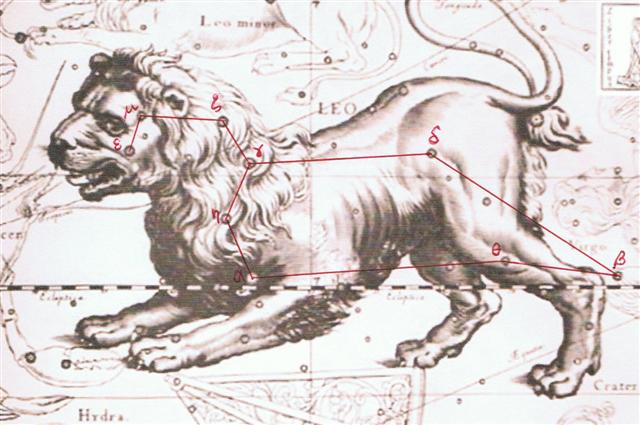|
1. The 'tail' of Leo is described by a triangular shape formed by Zosma (δ), Coxa (θ), and Denebola (β):
Allen explains Denebola as an abbreviation of the Arabic Al Dhanab al Asad, the Tail of the Lion. However, a Polynesian would presumably instantly know the name to be the Tail of Life (Deneb-ola) - cfr the name Mokuola (= Motu-ora) the Island of Life. 12h is close ahead and the summer half of the year (north of the equator or in the 'sky') is close to its end. A lion symbolizes 'land', a time for procreation, and the tail of a lion is therefore synonymous with the tail of life. With the heliacal rise of Denebola the time of plenty (Maghā, bountiful) is finished.
Counting from Regulus (153.7) to Denebola (179.3) there are ca 26 days. This distance is perhaps to be regarded as twice 13 days long:
Pūrva Phalgunī means 'first reddish one' and Uttara Phalgunī 'second reddish one' according to Wikipedia. Allen says the colour of Denebola is blue and that of Zosma is 'pale yellow, blue, and violet' - the star is through a telescope seen to be a triplet. He gives no colour for Coxa. Probably phalgunī is not here meant to be literally red. It could mean 'great', possibly denoting the great events of birth and death. At dawn and in the evenings the sky colours red. And we should remember: ... The Hindu Rohinī, a Red Deer, used also for the nakshatra in Scorpio marked by Antares, was unquestionably from the star's ruddy bue ... This is how Hevelius has drawn Leo (with my red lines and letters added):
The brightest star, according to the picture, is where the Lion has his testicles, below his very long tail. Hevelius has given us a Sign because there is no bright star in this location. He has probably indicated the rather insignificant 93 Leonis:
His intention may have been to indicate that 'life' does not stop with Denebola but continues with the 'off-spring' (hua). At the other end of Leo, the beginning, is Alterf (λ) - the star in the open mouth (as if a Sign of a the 'Lion season' opening up). From Alterf (144.4) to Denebola (179.3) there are 5 weeks, a rather short season. |
||||||||||||||||||||||||||||||||||||||||||||||||||||||||||||||||||||||||||||||||||||||||||||||||||||||||||||||||||||||||||||||||||||||||||||||||||||||||||||||||||||||||||||||||||||














